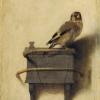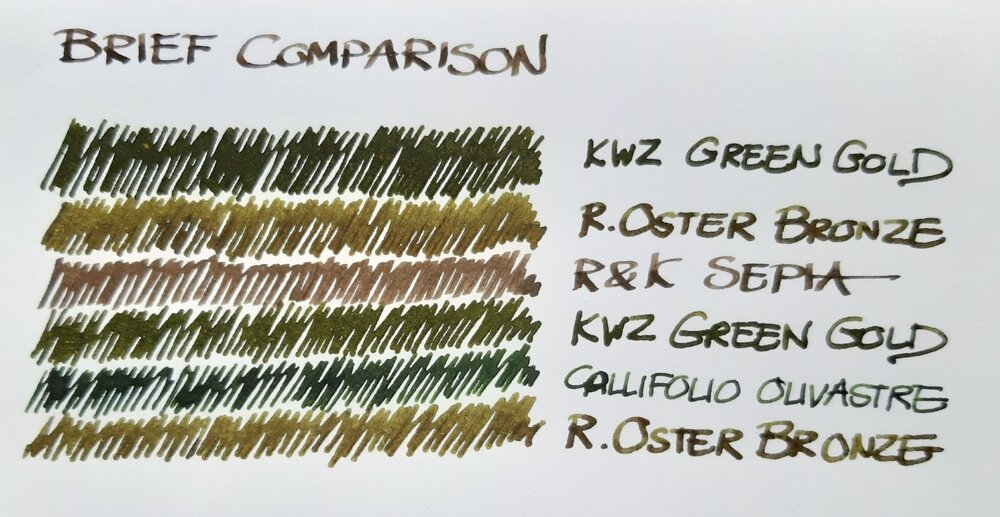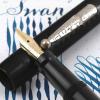Search the Community
Showing results for tags 'callifolio'.
-

Ink Shoot-Out : J.herbin Vert De Gris Vs Callifolio Olifants
namrehsnoom posted a topic in Ink Comparisons
Ink Shoot-Out : J.Herbin Vert de Gris vs L'Artisan Pastellier Callifolio Olifants In 2018, J. Herbin released a number of new inks in their "Perle des Encres" series. The one I fell in love with is Vert de Gris, a terrific grey-green-blue ink that rightfully deserved a spot in my favourite inks...- 15 replies
-
- ink shoot-out
- j.herbin
-
(and 3 more)
Tagged with:
-

Triple ink shoot-out : Callifolio Cassis vs Diamine Earl Grey vs Sailor chu shu
namrehsnoom posted a topic in Ink Comparisons
Triple Ink Shoot-Out : Callifolio Cassis vs Diamine Earl Grey vs Sailor chu shu A couple of weeks ago I did a review of Sailor Jentle chu shu, and noticed I had some other purple-grey inks that look fairly similar in writing – Diamine Earl Grey and L’Artisan Pastellier Callifolio Cassis....- 9 replies
-
- ink shoot-out
- callifolio
-
(and 7 more)
Tagged with:
-

Ink Shoot-Out : Rohrer&Klingner Verdigris vs Callifolio Equinoxe(6)
namrehsnoom posted a topic in Ink Comparisons
Ink Shoot-Out : Rohrer & Klingner Verdigris vs L’Artisan Pastellier Callifolio Equinoxe(6) A couple of months ago, I did a review of R&K Verdigris, and was pleasantly surprised by the ink’s colour and performance – it’s truly a classic. When looking at related inks, I noticed that L’Arti...- 9 replies
-
- ink shoot-out
- rohrer&klingner
- (and 5 more)
-
Just a brief note on a recent comparison: a bottle of Robert Oster Signature Bronze had been lingering in my ink drawer until I decided to use it a new acquisition by Atelier Veleray (more on that in the near future). It turned out greener than I'd expected, similar to KWZ Green Gold but slightly li...
- 11 replies
-
- robert oster
- kwz
-
(and 6 more)
Tagged with:
-
Does anyone know a US source for the Callifolio diluent?
-
L'Artisan Pastellier Callifolio - Bleu Ultramarine L'Artisan Pastellier is a small company in southern France that specialises in natural pigments, and offers customers authentic and reliable products in beautiful colours based on mineral or vegetable pigments. In a collaboration with Loic Raino...
- 5 replies
-
- lartisan pastellier
- callifolio
-
(and 2 more)
Tagged with:
-
Calling all L’Artisan Pastellier fans, please! I am preparing an order from L'Artisan Pastellier and having trouble picking a blue-black/blue-grey. Online samples of their Callifolio blue-blacks/blue-greys can look very similar. I already have Baikal, Gris de Payne from the Classique in...
- 7 replies
-
- artisan pastellier
- callifolio
-
(and 3 more)
Tagged with:
-
InkShift – L'Artisan Pastellier Callifolio Heure Dorée to Noir With their Callifolio line of inks, L'Artisan Pastellier has produced some really nice ink colours. Some of them are better than others, though. I really like Heure Dorée as a drawing ink, and it is undoubtedly a beautiful ink for jo...
- 5 replies
-
- inkshift
- lartisan pastellier
-
(and 3 more)
Tagged with:
-
L'Artisan Pastellier Callifolio - Bosphore L'Artisan Pastellier is a small company in southern France that specialises in natural pigments, and offers customers authentic and reliable products in beautiful colours based on mineral or vegetable pigments. In a collaboration with Loic Rainouard...
- 13 replies
-
- lartisan pastellier
- callifolio
-
(and 2 more)
Tagged with:
-
L'Artisan Pastellier Callifolio - Téodora L’Artisan Pastellier is a small company in southern France that specialises in natural pigments, and offers customers authentic and reliable products in beautiful colours based on mineral or vegetable pigments. In a collaboration with Loic Rainouard fro...
- 8 replies
-
- lartisan pastellier
- callifolio
-
(and 2 more)
Tagged with:
-
L'Artisan Pastellier Callifolio - Olifants L’Artisan Pastellier is a small company in southern France that specialises in natural pigments, and offers customers authentic and reliable products in beautiful colours based on mineral or vegetable pigments. In a collaboration with Loic Rainouard fr...
- 11 replies
-
- lartisan pastellier
- olifants
-
(and 2 more)
Tagged with:
-
L'Artisan Pastellier Callifolio - Sepia L'Artisan Pastellier is a small company in southern France that specialises in natural pigments, and offers customers authentic and reliable products in beautiful colours based on mineral or vegetable pigments. In a collaboration with Loic Rainouard from...
- 4 replies
-
- lartisan pastellier
- callifolio
-
(and 2 more)
Tagged with:
-
L'Artisan Pastellier Callifolio - Gris de Payne L’Artisan Pastellier is a small company in southern France that specialises in natural pigments, and offers customers authentic and reliable products in beautiful colours based on mineral or vegetable pigments. In a collaboration with Loic Rainouar...
- 12 replies
-
- lartisan pastellier
- callifolio
-
(and 2 more)
Tagged with:
-
L'Artisan Pastellier Callifolio - Baikal L’Artisan Pastellier is a small company in southern France that specialises in natural pigments, and offers customers authentic and reliable products in beautiful colours based on mineral or vegetable pigments. In a collaboration with Loic Rainouard from...
- 13 replies
-
- lartisan pastellier
- callifolio
-
(and 2 more)
Tagged with:
-
L'Artisan Pastellier Callifolio - Bleu Méditerranée L'Artisan Pastellier is a small company in southern France that specialises in natural pigments, and offers customers authentic and reliable products in beautiful colours based on mineral or vegetable pigments. In a collaboration with Loic Rai...
- 6 replies
-
- lartisan pastellier
- callifolio
-
(and 3 more)
Tagged with:
-
L'Artisan Pastellier Callifolio - Equinoxe(5) L’Artisan Pastellier is a small company in southern France that specialises in natural pigments, and offers customers authentic and reliable products in beautiful colours based on mineral or vegetable pigments. In a collaboration with Loic Rainouard...
- 7 replies
-
- lartisan pastellier
- callifolio
-
(and 2 more)
Tagged with:
-
L'Artisan Pastellier Callifolio - Yalumba L'Artisan Pastellier is a small company in southern France that specialises in natural pigments, and offers customers authentic and reliable products in beautiful colours based on mineral or vegetable pigments. In a collaboration with Loic Rainouard f...
- 5 replies
-
- lartisan pastellier
- callifolio
-
(and 2 more)
Tagged with:
-
So I really didn't want yo get into mixing inks, it took me a while to match the right pen to each of my 29 inks and I didn't want even more complications, but... Seeing Équinoxe 6 was depleting I got a 50ml pouch only to find it doesn't look like what I liked, which has been widely reported: perhap...
- 1 reply
-
- équinoxe 6
- skrip blue
-
(and 3 more)
Tagged with:
-
L'Artisan Pastellier Callifolio - Cassis L’Artisan Pastellier is a small company in southern France that specialises in natural pigments, and offers customers authentic and reliable products in beautiful colours based on mineral or vegetable pigments. In a collaboration with Loic Rainouard from...
- 10 replies
-
- lartisan pastellier
- callifolio
-
(and 2 more)
Tagged with:
-
L'Artisan Pastellier Callifolio - Bleu Azur L'Artisan Pastellier is a small company in southern France that specialises in natural pigments, and offers customers authentic and reliable products in beautiful colours based on mineral or vegetable pigments. In a collaboration with Loic Rainouard...
- 9 replies
-
- lartisan pastellier
- callifolio
-
(and 3 more)
Tagged with:
-
L'Artisan Pastellier Callifolio - Bordeaux L'Artisan Pastellier is a small company in southern France that specialises in natural pigments, and offers customers authentic and reliable products in beautiful colours based on mineral or vegetable pigments. In a collaboration with Loic Rainouard...
- 14 replies
-
- lartisan pastellier
- callifolio
-
(and 2 more)
Tagged with:
-
L'Artisan Pastellier Callifolio - Havane L'Artisan Pastellier is a small company in southern France that specialises in natural pigments, and offers customers authentic and reliable products in beautiful colours based on mineral or vegetable pigments. In a collaboration with Loic Rainouard from...
- 4 replies
-
- lartisan pastellier
- callifolio
-
(and 2 more)
Tagged with:
-

Ink Shoot-Out : J. Herbin Poussière De Lune Vs Callifolio Bourgogne
namrehsnoom posted a topic in Ink Comparisons
Ink Shoot-Out : J.Herbin Poussière de Lune vs L'Artisan Pastellier Callifolio Bourgogne Over the course of the past few years I have developed a taste for dusty, murky inks. Excellent colours for gloomy autumns and dark winter evenings... Two of the inks I love very much are J. Herbin’s Poussière...- 14 replies
-
- poussière de lune
- bourgogne
-
(and 3 more)
Tagged with:
-
L'Artisan Pastellier Callifolio - Bonne Esperance L'Artisan Pastellier is a small company in southern France that specialises in natural pigments, and offers customers authentic and reliable products in beautiful colours based on mineral or vegetable pigments. In a collaboration with Loic Rainou...
- 8 replies
-
- lartisan pastellier
- callifolio
-
(and 2 more)
Tagged with:
-
L'Artisan Pastellier Callifolio - Inca Sol L'Artisan Pastellier is a small company in southern France that specialises in natural pigments, and offers customers authentic and reliable products in beautiful colours based on mineral or vegetable pigments. In a collaboration with Loic Rainouard fr...
- 5 replies
-
- lartisan pastellier
- callifolio
-
(and 2 more)
Tagged with:




